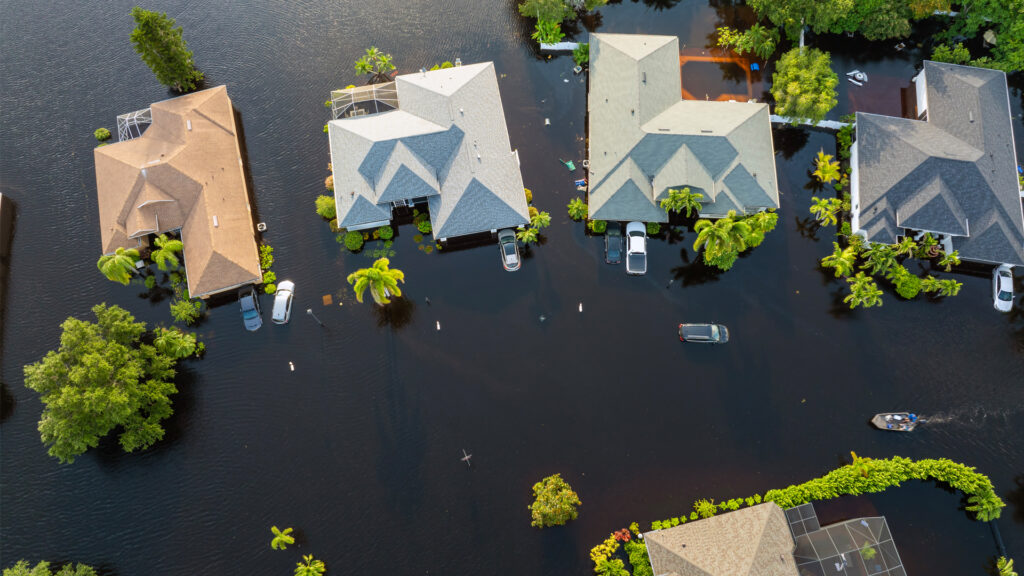This essay was written as part of a Ph.D. seminar called “Theorizing Infrastructure” for Florida Atlantic University’s graduate program in comparative studies. An overview of the course by professor Stacey Balkan and other essays from students can be found here.
By Alexander D. Veal
This is a prologue to a tale I’m calling “Crossing Acuosa.” In this chapter, a teacher introduces this season’s topic: the history of the waters once called Florida. He explains a 200-year evolution from the United States to the Great United Commons, from Florida to Acuosa.
I accept my anticipatory grief of losing Florida since much of it is underwater. But instead of a dystopia, Acuosa is a utopic, fun and hopeful society. Its emphasis on mobility and distance is a critique of modern transportation. Interstate highways are mostly submerged underwater or swallowed by swamps, and the once-drained Everglades has become a sea connecting the southern commons.
The schoolhouse was an old government hall covered in beige plaster. This building, once governing a city that no longer exists, sits too close to Okeechobee Bay to last another decade. “One good storm will knock this place into the water,” Sasha thought.
Sasha sought shade under the courtyard’s gumbo limbo tree, dropping their pack and leaning against its shedding trunk. Class was held outside since it’s a cool 81 degrees F out. Winter storms aren’t unusual, but Sasha can’t remember the last one. Hurricanes come yearly, but their compound can handle it. They’ve heard old stories of storms hitting monthly, but that was decades ago.
The teacher calls class into session. After five minutes, everyone’s drenched in sticky sweat, the courtyard fragrant with pheromones, salt and sap.
“This season, we’re learning the history of Acuosa. These waters were once called ‘Florida,’ which was part of an old country called the United States of America.”

Sasha loves listening to stories about the Industrial World. Their great-grandparents tell tales of storms swallowing buildings, cities falling into oceans, blizzards suffocating towns and wildfires devouring forests. Part of Sasha doesn’t believe it. The Commons aren’t perfect, everyone just had to be considerate. In Acuosa, you always considered water.
The teacher wipes sweat from his brow while asking, “Who knows why we call our home ‘Acuosa’?” Sasha knows but hesitates raising their hand.
The teacher continues, “‘Acuosa’ means ‘watery’ in traditional Spanish, which is one of the mother tongues of our language today.”
In what was once called Florida, water drowned a place called Miami – its remnants now forming the half-sunk city on New Miami Island.
The history goes: The Exposure was the reckoning of their society’s faults caused by colonization, extraction, capitalism and more dangerous ideas. The Revolution was the war deciding what to do about it. Once new governments seized power, roads became waterways, buildings were raised above the tides, first floors turned into swamp gardens, petro-vehicles faded, ferries flourished and fossil fuels were abandoned.
The Production Stop halted producing new items, especially single-use plastics. Old fabrics were sewn into new clothes, machines were rebuilt, and technology was repaired and reused. The Agricultural Re-Orientation focused on local food for local communities, requiring crops be grown near their destinations. And Revolutionary Botany learned to deteriorate harmful materials, like concrete, and grow regenerative materials. Mycelium ate asphalt and buildings were made from biomass. Like all life, buildings die, too. The old roads are now underwater, with many routes still guiding Crossings.
Soon, the Industrial World crumbled into an oily puddle for fungi to slurp up. Eventually, a familiar world blossomed.
Massive grids failed before, so new ones remained local. As destructive industries retired, environments flourished. Once a lake, Okeechobee Bay now meets the Atlantic and the Gulf, forming the Everglades Sea. Sadly, many old cities didn’t survive. Old Orlando was lost in the war, Old Lauderdale to the water. New cities like Drytown and Gatorland emerged, but those are commons now.
Old industries changed, like “police.” The need for state-sanctioned violence dwindled since everyone’s needs were met. Besides, more labor was required to transform energy grids, sewer systems and farmlands. There were plenty of buildings for shelter, so housing became universal.
Collaboration and mutual aid regimes allowed global cooperation to undo centuries of greed and exploitation. Before The Exposure, the old world was full of hypocrisy, lies and manipulation. The Admission was admitting guilt – old countries acknowledging extractive capitalism, colonialism, slavery, genocide and other dangerous ideas caused the climate to change and planetary suffering. Ultimately, governments ceded power back to the people, who created The Commons.
“Which leads to Acuosa. The name started as satire, but it’s stuck.” When everything ended, more commons sprouted. Together, they formed the Greater United Commons – a decentralized, locally governed web of mutual ambitions for a happier, healthier world. Thus began a new era: our Common World.
Banner photo: Ten Thousand Islands National Wildlife Refuge, in current-day Florida (iStock image).
Sign up for The Invading Sea newsletter by visiting here. To support The Invading Sea, click here to make a donation. If you are interested in submitting an opinion piece to The Invading Sea, email Editor Nathan Crabbe at nc*****@*au.edu.




Superior content.
Brilliant read! 🙏🩷💚